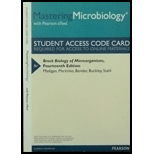
Brock Biology of Microorgan. -Access
14th Edition
ISBN: 9780321943736
Author: MADIGAN
Publisher: PEARSON
expand_more
expand_more
format_list_bulleted
Concept explainers
Textbook Question
Chapter 10.1, Problem 1MQ
- Distinguish between a mutation and a mutant.
Expert Solution & Answer
Want to see the full answer?
Check out a sample textbook solution
Students have asked these similar questions
Distinguish between a mutation and a mutant
Define the term Mutation?
explain what mutations are and how they occur?
Chapter 10 Solutions
Brock Biology of Microorgan. -Access
Ch. 10.1 - Distinguish between a mutation and a mutant.Ch. 10.1 - Distinguish between screening and selection.Ch. 10.2 - Do missense mutations occur in genes encoding...Ch. 10.2 - Why do frameshift mutations generally have more...Ch. 10.3 - Why does the Ames test measure the rate of...Ch. 10.3 - Which class of mutation, missense or nonsense, is...Ch. 10.4 - Prob. 1MQCh. 10.4 - Prob. 2MQCh. 10.4 - Prob. 3MQCh. 10.5 - Prob. 1MQ
Ch. 10.5 - Prob. 2MQCh. 10.5 - Prob. 3MQCh. 10.6 - During transformation a cell usually incorporates...Ch. 10.6 - Prob. 2MQCh. 10.7 - Prob. 1MQCh. 10.7 - What is the major difference between generalized...Ch. 10.7 - Why is phage conversion considered beneficial to...Ch. 10.8 - In conjugation, how are donor and recipient cells...Ch. 10.8 - Explain how rolling circle DNA replication allows...Ch. 10.8 - Prob. 3MQCh. 10.9 - In conjugation involving the F plasmid of...Ch. 10.9 - Prob. 2MQCh. 10.9 - Prob. 3MQCh. 10.10 - Why is it usually more difficult to select...Ch. 10.10 - Why do penicillins not kill species of Archaea?Ch. 10.11 - Prob. 1MQCh. 10.11 - What is the significance of the terminal inverted...Ch. 10.11 - How can transposons be used in bacterial genetics?Ch. 10.12 - Why is the CRISPR system considered a prokaryotic...Ch. 10.12 - Prob. 2MQCh. 10 - Write a one-sentence definition of the term...Ch. 10 - Prob. 2RQCh. 10 - Prob. 3RQCh. 10 - Prob. 4RQCh. 10 - Prob. 5RQCh. 10 - What are heteroduplex regions of DNA and what...Ch. 10 - QExplain why recipient cells do not successfully...Ch. 10 - QExplain how a generalized transducing particle...Ch. 10 - QWhat is a sex pilus and which cell type, F or F+,...Ch. 10 - Prob. 10RQCh. 10 - Prob. 11RQCh. 10 - Prob. 12RQCh. 10 - QExplain why incoming DNA recognized by a short...Ch. 10 - A constitutive mutant is a strain that...Ch. 10 - Although a large number of mutagenic chemicals are...Ch. 10 - Why is it difficult in a single experiment to...Ch. 10 - Prob. 4AQ
Knowledge Booster
Learn more about
Need a deep-dive on the concept behind this application? Look no further. Learn more about this topic, biology and related others by exploring similar questions and additional content below.Similar questions
arrow_back_ios
arrow_forward_ios
Recommended textbooks for you
 Human Heredity: Principles and Issues (MindTap Co...BiologyISBN:9781305251052Author:Michael CummingsPublisher:Cengage Learning
Human Heredity: Principles and Issues (MindTap Co...BiologyISBN:9781305251052Author:Michael CummingsPublisher:Cengage Learning

Human Heredity: Principles and Issues (MindTap Co...
Biology
ISBN:9781305251052
Author:Michael Cummings
Publisher:Cengage Learning
Mitochondrial mutations; Author: Useful Genetics;https://www.youtube.com/watch?v=GvgXe-3RJeU;License: CC-BY